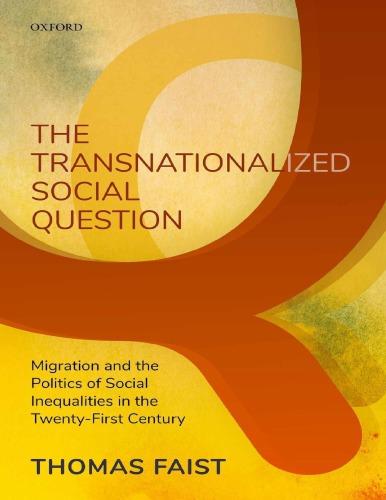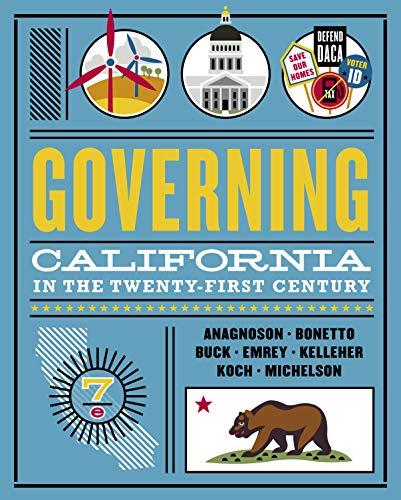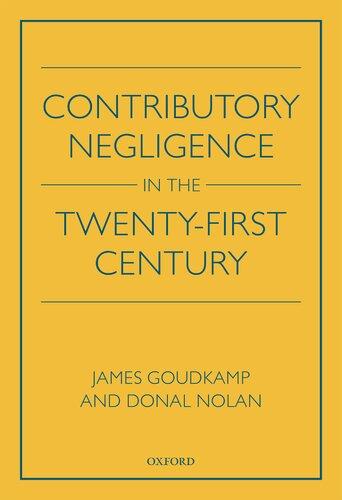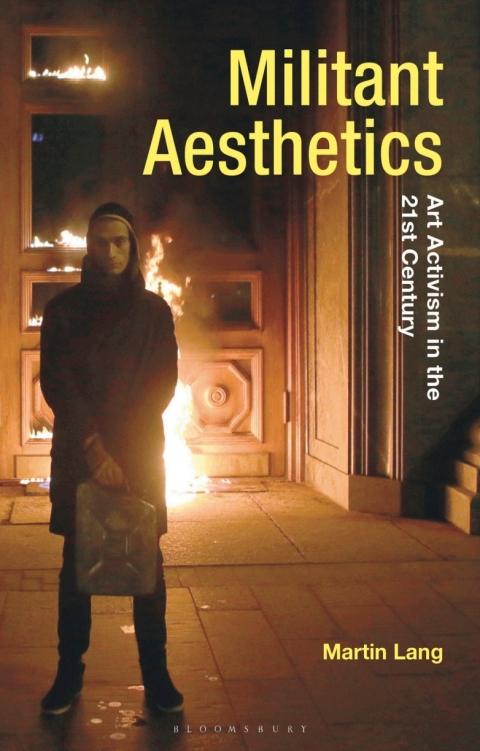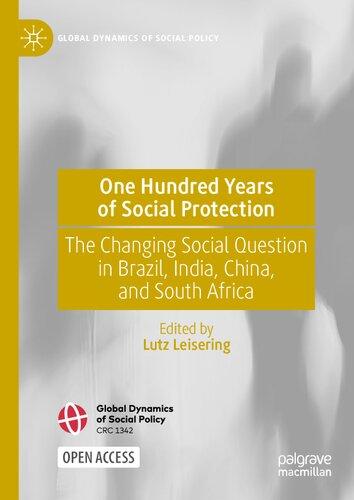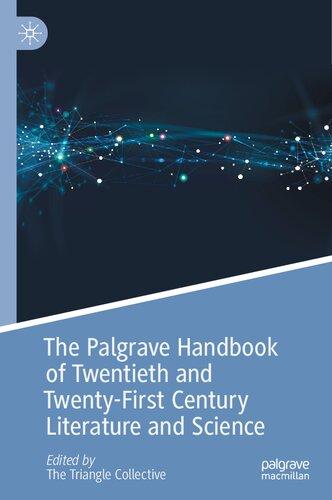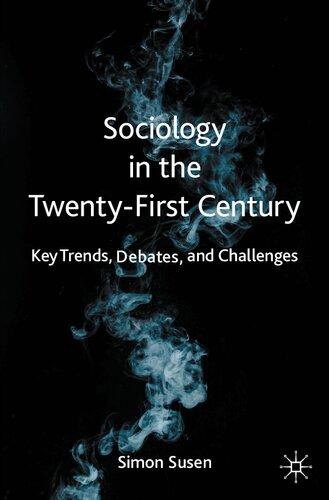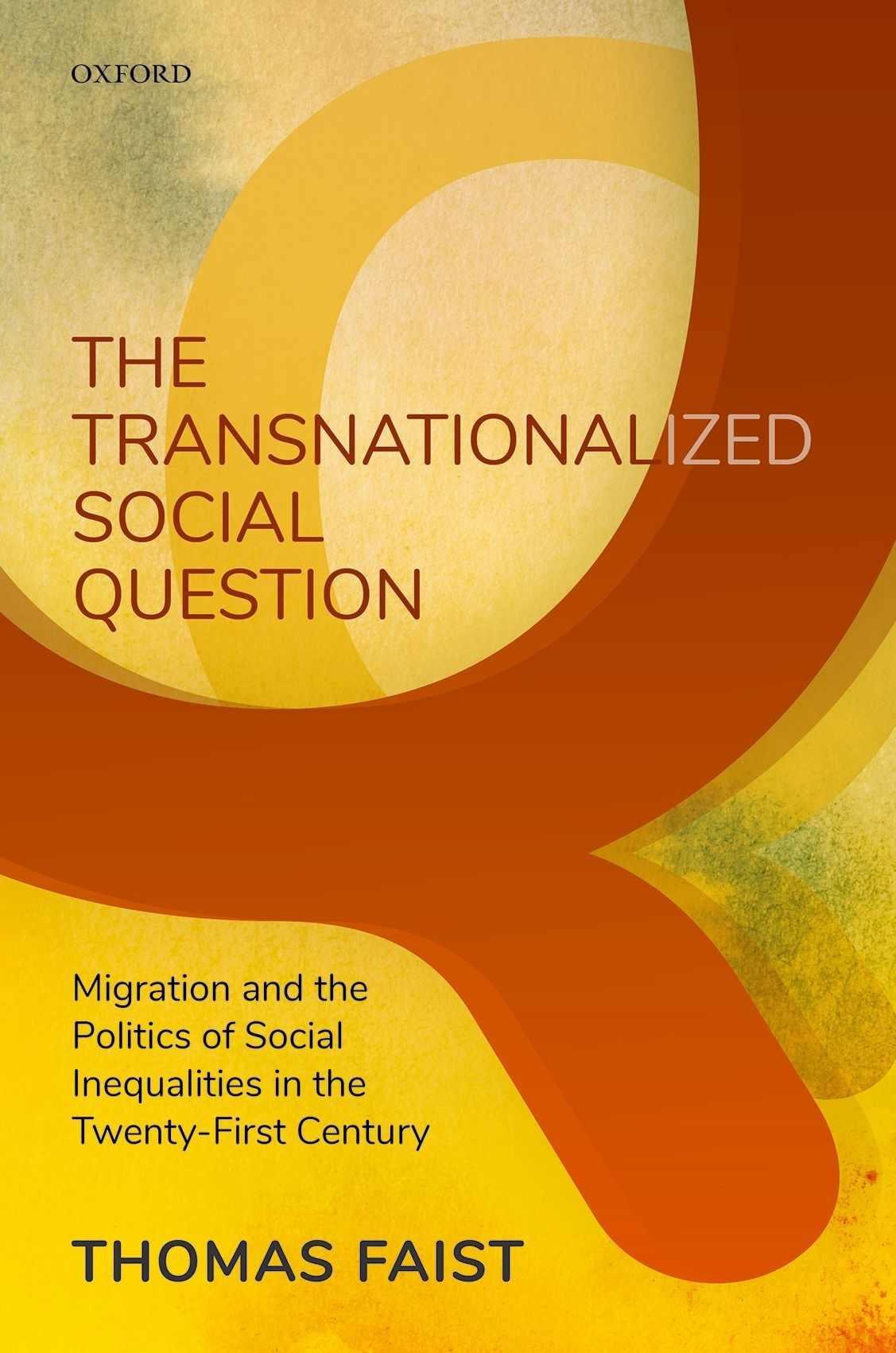Introduction
MigrationastheTransnationalizedSocialQuestion
The social questionis back. Yet today’s social questionis not primarilybetweenlabour and capital, as it was in the nineteenth century and throughout much of the twentieth. In earlier periods class differences dominated conflicts. While class has always been criss-crossed by manifold heterogeneities, notleastofall cultural ones around ethnicity, religion, and language, itis these latter heterogeneitiesthathavesharpenedinsituationsofimmigrationandemigrationover thepastdecades. Thecontemporarysocial questionis locatedattheinterstices betweentheglobal Southandtheglobal North. It finds its expression in movements of people seeking a better life or fleeing unsustainable social, political, economic, and ecological conditions. It is transnationalized not only because migrants and their significant others entertain ties across the borders of national states, staying in touch with family and friends, or receiving or sending financial remittances in transnational social spaces. Also of importance are the cross-border recruitment schemes for workers and the crossborder diffusion of norms appealed to in the case of migration for example, the social right to decent workas a humanright. Moreover, migrationcanbecome anissue ofinclusionor exclusionin fields important to life chances, such as education, work, social protection, and housing, in the emigration, transit, or immigrationstates a sort oftransnationalizationofnational states. And, as in thenineteenthcentury,political conflictsarise,constitutingthesocial questionasapublicconcern.
Economic and political inequalities characterize the modern world. In observing the changing patternof global income distribution byno means the onlyindicator of unequal life chances but an importantone one mayevensurmise thatcross-border migrationhas played anever more important role in addressing social inequalities because of the increasing significance of location and membership for life chances of individuals and groups. According to this perspective, unlike conditions in the mid-nineteenth century, when income inequality could be explained by class understood as the ownership of the means of production, the situation at the start of the twenty-first century is different. While in the late nineteenth century, around 1870, about 50 per cent of income differences couldbeattributedtowhether or notpeopleownedthemeans ofproduction,andabout20 per centtolocation,thatis,thecountryinwhichonewasliving,thisrelationshiphasalmostreversed. In 2000, more than two-thirds of global income differences could be attributed to huge gaps in averageincomebetweencountries,whereastheshareattributedtoclasshasdeclinedconsiderably,to around a quarter (Milanovic 2012: 205). In other words, if we were to construct a global map of income inequality, showingwhere eachhousehold or individual stood vis-à-vis everyone else inthe
world (that is, combining information on within- and between-country inequality), the relative standing of each household or individual would be shaped in large part by whether they lived in a poor or a wealthy state. In general, the available empirical data on national incomes show unequivocallythatinequalitybetweencountries inthetwentiethcenturywas higher thantheinequality exhibitedwithinanysinglenational state(Oxfam2017).Other sources confirmthatincome inequality betweencountries accounted for roughlytwo-thirds of overall world income inequalityinthe 1990s (Korzeniewicz and Moran 2009). Moreover, average incomes in the richest countries far exceed those in the poorest countries, estimated to be forty to fifty times greater in the former during the 1990s (Bourguignonand Morrisson2002). Note thatlocationhere mainlyrefers to countries. Ideally, we would need to consider other locational differences, suchas rural/urbanwithinnational states in betweenwhichinternal migrationmayoccur.
The importance of location to inequality cannot be overestimated: ‘Nearly all the differences in wages betweenindividuals inrichand poor countries are explained bythe locationof the work, not their personal characteristics’ (Pritchett 2006: 20). Although there is much debate about countervailingtrends withrespectto the pasttwo decades, mostlydue to increasinglevels ofincome in countries such as China and India (cf. Bourguignon 2015), the unequal pattern of income distributionhas beenremarkablystable over the past 200 years (Lindert and Williamson2003). The shift from class to location and thus also citizenship is apparent in explanations of economic privilege. Standard analyses of economic privilege focusing on national systems, for example, identifyclassprivilegeasthedecisivefactor shapingeducational and,eventually,economicprivilege (Bourdieu1984).Bycontrast,location-specific privilege is oftenreferredtowhenseekingtoaccount for the devaluationofskills and expertise brought bycross-border migrants to immigrationcountries (e.g.Bauder 2003).
We arrive at a similar observation when moving from income and labour migration to human security and forced migration. In today’s global political order, there are now many more sovereign states than in the nineteenth century, but also states in disarray as suggested by terms such as state formation and nation-building, but also state dissolution, state failure, and civil war. The success of the diffusionofthe Europeanmodel ofnational state formationacross the globe is also a contributing factor to the patterns of forced migration. One of the paradoxes of this diffusion is that its very success coincides with internal struggles and with often massive external military interventions and continued economic dominationof states inthe global Southbythose inthe global North. Its spread also relates to the conflicts over establishing and maintaining national state structures following decolonization(Tilly1990: chapter 5).As a result,the verysuccess ofthe model andthe concomitant violent struggles have been accompanied by more and more internal displacement and forced migration across borders. Asymmetries are thus to be found not only in the economic realm, as measured, for example, by wide differences in income and wealth between countries in the global South on the one side and the global North on the other, but also in the political realm (Zolberg, Suhrke,andAguayo1989).Locationasaproxyfor citizenshipmattersindeednotonlywithrespectto material inequalities such as income but also human security. The total number of refugees and internally displaced people reached more than sixty million in 2015, the highest number since the Second World War. More than 80 per cent of them remain in the countries of origin (internally displaced persons (IDPs)) or innearbycountries inthe developingworld (UNHCR 2016). There is also a patternwithrespect to countries of origin: not surprisingly, the least peaceful countries onthe planetover the pastyears, accordingto the Global Peace Index, suchas Afghanistan, Iraq, Syria, and Somalia, lack efficient government monopoly of violence and rule of law. They have experienced
highratesofforcedemigration(Donini,Monsutti,andScalettaris2016).
The increased importance of location for life chances is heightened by what has been called the mobility or migration paradox. On the one hand, as the global economic inequalities and political power asymmetries suggest, the incentives for cross-border migrationare nowadays as highas ever. Furthermore, images of a better life elsewhere have spread around the globe via mass media, includingsocial media. Giventhe growingimportance oflocationover the past150 years, we should expectexitas anoptionto gainimportance vis-à-vis voice as a response to global inequalities inthe South–Northcontext(cf. Hirschman1970). Onthe other hand, despite sucheasyaccess to hope for a better future, access to cross-border mobility is starkly limited, if not directly contradicted, by state restrictions. One may even claim that, since the 1970s, crossing borders into states of the global North has become even more cumbersome for the majority of migrants. Seen in this way the pincer movement between economic incentives, political force, and eased access to images of hope on the one hand, and growingmobilityrestrictions for manymigrants, especiallythose deemed low-skilled, on the other, has tightened. Hence one of the most plausible responses to increasing life chances, giventheimportanceoflocationinaglobalizedworld,isincreasinglystifledandprohibited.
The increased status of location has implications for all sorts of cross-border mobility, not only for relatively voluntary movements but also for forced migration. Socio-economic inequalities as well as direct and indirect violence surround the spread of capitalist modes of production and the national state model as global patterns. These developments are transnational notonlyinthe sense of cross-border migrationas suchbut also withrespect to the consequences of migrationinthe regions of origin, transit, and immigration. In the wake of social inequalities in the nineteenth century, the main response in what is nowadays called the global North was social protection through national welfare states. The term welfare state here refers to providing members of the state with a certain amount of social protection, that is, social security based on notions of equality of national citizens, byregulatingand redistributingsocial risks and providingservices.1 Clearly, state-sponsored social protection is oriented toward norms: it ‘refers to public actions taken in response to levels of vulnerability, risks, and deprivation, which are deemed socially unacceptable within a given polity and society’(Norton, Conway, and Foster 2001: 21). Such forms of social protection include rights andpublic policies meanttoaddress the risks causedbylabour marketparticipationandother realms of social and economic life, such as challenges to health, but also in proactive ways such as education. Typical ways to deliver social protection are state-sponsored schemes, for example in social insurance against risks such as accidents, unemployment, health, and old age, and social services offeredbypublic andprivate organizations.Viewedglobally,equallyimportantare schemes based on kinship and community ties. With respect to migrants, financial remittances, mobility for care, and informationare importantelements involved insocial protection(Faistetal. 2015; Parella andSperoni 2018).
Throughmigration, social protectionconnects various social spaces around the world, and speaks to central concerns not only of national welfare states in the global North but also to what could be called developmental states in the global South. For example, the majority of goals listed in the Agenda for Sustainable Development, adopted by the members of the United Nations (UN) in 2015, refer to basic elements of social protection, suchas reducinghunger and poverty, ensuringaccess to clean water, health care, and education, empowering women, decreasing social inequalities across theglobebutalsowithincountries,andprotectingthehumanenvironment(UN2015).
The term‘social question’is notjustanother termfor social inequalities. Social inequalitycanbe
understoodas aphenomenonthatoccurs whensomeactors,due totheir social position,tendtoobtain valuable goods more frequently than others. By contrast, the social question mainly concerns the perceptionofandthepolitical mobilizationaroundsocial inequalities basedonnormsofequality as unfair or unjust onthe one hand, and the legitimationof social inequalities onthe other. As to the norms of equality, nineteenth-century workers’ movements did not organize around the issue of poverty but around the claimto equality. Nowadays, the politics around inequalities in migration is ubiquitous, ranging from debates over the causes and drivers of cross-border migration to demographic challenges in emigration and immigration countries, resentment over competition between native populations with newcomers or returnees, and, more generally, conflicts over the social integration of migrants in areas of settlement and return, and social integration of political communities on state and local levels with respect to changing understandings of membership (see, e.g.MessinaandLahav2006).
Cross-border migration, involving as it does gross asymmetries and social inequalities between regions of the world and concomitant political conflicts, is an ideal field for studying the transnationalizedsocial question.Inequalities across states constitute a contextinwhichcross-border migration becomes attractive, and are politicized within national states by way of immigration and emigration.
The social question is a transnationalized question because of the cross-border transactions involved. The core questionto be answered is thus: how is cross-border migrationconstituted as the social question of our times? This framing question requires an analysis of how social inequalities are constituted and reconstituted in the course of cross-border migration; hence an analysis of the social mechanisms of the (re)production of inequalities and the quest for more equalities. Four key areas associatedwiththis coreproblemareexaminedinthis volume.PartIanalyses exactlywhathas changed since the nineteenth century, when the social question was discussed for the first time, and whatkinds ofsocial inequalities are created inthe migratoryprocess and how. PartII discusses how social protection across borders ameliorates and reproduces patterns of inequalities. Migrants and other categories of mobile persons, such as those engaged in circular mobility, sustain dense and continuous ties across borders, in transnational social spaces; therefore, the focus is on how social protection is organized in the context of cross-border migrations and the impact it has on social inequalities. Part III examines the consequences of social inequalities in cross-border migration for political struggles over access to (social) rights and membership, and the dynamics involved insuch struggles in immigration contexts around market liberalization, de-commodification, cultural pluralism, and securitization, and inemigrationcontexts withrespectto diasporas and the migration–developmentnexus.PartIVlooks to future engagement, and how the transnationalized social question istobeseeninlightofenvironmental destructionandclimatechange.Italsoexaminesmoregenerally the role played by social scientists in portraying the transnationalized social question in the public arena.
The mainthesis proposed here is thatthe growingimportance oflocationand thus membership in states for lifechances is drivingthe(re)productionofinequalities andthepolitics aroundthenexus of cross-border migrationandsocial protection.Althoughclaims toequalityhave risenandthe potential for cross-border migration has increased, the welfare state and the security state (characteristics of the global North with their inclusionary logic toward (quasi-)full members and exclusionary social closure toward non-members) prevents larger-scale cross-border migration. At first sight, we would expect exit as an option to gain importance vis-à-vis voice as a response to global inequalities. Yet what we observe are developments which counteract this expectation. First, given the restrictive
immigrationpolicies ofstates inthe global North, itis notexitand entryoflabour butthe mobilityof capital thathas stronglyincreasedover the pastdecades (Heldetal. 1999). Restrictive policies have also meant that exit of citizen-workers is not a credible threat to those governing in the states of emigration. Second, looking at immigration states, voice around class has increasingly been complemented byvoice around cultural heterogeneities, suchas ethnicity, race, and religion, butalso more general ones such as gender. Overall, the political mobilization around social inequalities a necessary condition to speak of the transnationalized social question has moved from a focus on redistribution to one which also includes issues of recognition; from issues of exploitation in the productionprocess to those ofinclusionand exclusioninadditional fields, suchas politics, law, and education. These processes have been accompanied by large-scale social transformations, often called globalization. InEurope, for example, the transformationofdense national social protectionis not compensated by corresponding transnational or supranational policies. This situation in turn partlyfeeds into further political mobilizationaround inequalities, notonlybymigrants butbynative populations. Nonetheless, currently, the issue of exploitation is coming back with a vengeance; this time not only through the exploitation of humans by humans but of nature by humans, resulting in a widespread‘lossofhabitat’(Sassen2016).
Today’s transnationalized social question with respect to migration occurs in a context fundamentally different from that of the nineteenth century. On the emigration side, in the nineteenth century, it was possible for the poor of Europe to migrate to settler colonies in America and elsewhere. The same was true ofthe South(East) Asianmigrationsystem. Despite or because of the fact that location and membership have become more important for life chances, genuine opportunities have become fewer and fewer. In the nineteenth century, large-scale outmigration functioned like a demographic safetyvalve for Europe (Hoerder 2003). For today’s potential crossborder movers the options are more limited. A lower percentage of people from countries in the global Southare able to move to the global North(cf. Segal 1993). It is ironic that at the time when location matters even more for life chances than before, there are fewer chances for cross-border migration. On the immigration side, in the nineteenth and early twentieth centuries, there was often resistance against migrant labourers and refugees, and efforts were made to select only the most wanted and welcomed. Today, the barriers to entry have risen considerably, in large part because controls at borders, especially remote controls, have become more sophisticated, and selection processes are aiming more at high-skilled rather than low-skilled migrants. The proportion of migrants with a tertiary education (college or university degree) is increasing. The number of migrants entering countries of the Organisation for Economic Co-operation and Development (OECD) with such qualifications has grown by two-thirds since 2000, reaching about a third of all migrantsinthe2010s(UN-DESA2013: 1).
Cross-border migration is a crucial research field for understanding social inequalities and responses tothem,suchas social protection,aroundthe world.There is a transnational puzzle: social life is increasingly characterized by cross-border linkages, while primary access to resources regardingsocial protectioncontinues,toalargeextent,tobelinkedtothenational welfarestateinthe global Northor thedevelopmentstateintheglobal South.Inthenineteenthcenturyandthefirsthalfof the twentieth, the conflict betweencapital and labour became the mainaxis ofpolitical contentionin addressingthe social question. That divisionwas also the object of compromise innational welfare states in Europe. In the global South, the idea of development came to characterize the role of the state after the Second World War inthe contextofthe Cold War. Migration, byand large, canbe seen as a form of transnationalization from below, often framed in public and academic debates as a
growing chasmbetween those who benefit fromglobalization the intensified movement of capital, goods, and services across borders and those who objectively and/or subjectively have lost (Graham2001; Vision Europe Summit 2017). Against this background a spate of recent scholarship made far-reaching claims regarding the importance of mobility but also of cross-border interactions more generally for life chances. In the words of Ulrich Beck, ‘[t]he possibilities for bordertranscending interactions and mobility have become important factors influencing the positioning in the hierarchy of inequality in the global age’ (2012: 1028). By contrast, the local/national then denotes anunfavourable positionina systemofinequalities inthatthe ‘local ina globalized world is a sign of social deprivation and degradation’ (Bauman 1998: 2–3). The global–local binary, sometimes portrayed as a global–national binary, is thus used to attribute life chances on different scales,connectedtothe claimthatthis is a relativelynew developmentbroughtaboutinthe course of increasingcross-border transactionsofcapital over thepastfew decades.
Cross-BorderMigration and Inequalities
Theterm‘migrant’is usedherewhenmigrationreferstothosewhomoveintonew contexts,whilethe term‘emigrant’istakentomeanthosemigrantswholeavetheir stateoforiginfor another country,and ‘immigrant’is employed to describe the perspective of the immigration country into which migrants immigrate. And while there is a politico-legal distinction between labour migrants on the one hand and refugees on the other, the termmigrant is used as an umbrella termreferring to all those crossborder moverswhostayabroadfor morethanayear.
It should be noted that there is no universally agreed-upon definition of the term migrant. The concept does often connote persons who stay abroad for more than one year (UN 2016b: 18). Yet there are other forms of mobility, for example, which are often not counted as forms of migration, such as international student mobility, circular migration, seasonal mobility, posted or seconded worker mobility, or expatriate worker mobility. Here, the term migrant thus encompasses highly diverse types of people onthe move, bothwithinand betweencountries: people who are permanent migrants, temporary contract labour, professional and business migrants; students; people who are forcedtomoveasasylumseekersandrefugees;peoplewhomovefromtherural countrysidetocities; people movingfor marriage and familyreasons;people who exitareas ofenvironmental degradation; people who escape from persecution and conflict within their own countries; people who are trafficked; and people who engage in onward movements to other countries, or who return to the countryoforigin. Moreover, people oftenshiftbetweenthese categories: theymayenter a countryas tourists or visitors, for example, but then are stranded, overstay, work, or apply for asylum. Some may settle permanently, and eventually become citizens. Also, internal migrants may at times move across national state borders and become international migrants (VanHear 2009). All ofthese forms ofmobilityarealsoincludedinthebroaddefinitionofmigrationusedhere.
Ina verybroad sense, contemporarycross-border South–Northmigrationis a late consequence of European domination of the world through colonialismand imperialism. It can be seen as a sort of post-colonial counter flow, instigated partlybythe Europeanconquest of territories inthe rest of the world. Cultural heterogeneities such as race and ethnicity can serve as crucial examples of how patterns ofdominationweretransferredandadaptedbackandforthfromthecolonizedworldtothose of the colonizers. Inequalities are thus patterned not only along class antagonism (Karl Marx) or social strata (MaxWeber),butalsoalongdifferences suchas race,ethnicity,religion,andlanguage
along with other important ones such as gender. Not surprisingly, most of these inequality patterns have been co-produced in the global North, for example, racial oppression a process aptly called ‘internal colonialism’(Blauner 1972).
Cross-border migration is a strategic research site to analyse how social inequalities have been perceived, have become a matter of contention, and have been settled into political compromises. Cross-border migration is a visible reflection of global inequalities arising in manifold contexts characterized by inequalities within and between states, such as rapid population growth and the dearth of opportunities for making a living, a shortage of jobs for the young skilled and unskilled entering labour markets, unstable political situations (even civil wars) and a host of additional factors. An abundance of literature deals with the link between migration and inequalities, but primarily indirectly, often through topics such as migration and development, or the integration of migrants in destination countries. In order to grasp the nexus of migration and inequalities, we first needtotakeheedofthespecificcharacteristics ofcontemporarycross-border migration.Onthebasis ofthis picture itis thenpossible to gauge the importance ofthe change oflocationfor life chances in economic,political,andcultural perspectives.
Examining migration helps us to understand the links between the disparate, fragmented social spaces of unequal life chances and social protection. Social protection strategies comprise, at the individual and collective levels, multiple forms of coping with the risks associated with production and (un)employment, education, training, senior care, health, housing, disability, familyformationand children,andoldage.Goingevenfurther,social protectionstrategies alsomatter incontexts ofthreat, such as wars, when people flee violence, and in processes of environmental destruction, such as natural disastersandanthropogenicclimatechange.
International or, more precisely, cross-border migration is defined in general terms as people’s movement to other regions leading to temporary or long-term forms of settlement and resettlement (Bartram, Poros, and Monforte 2014). The most important drivers of immigrationfromEuropeanbut also non-European regions were labour needs based on recruitment programmes and colonial links, as well as humanitariancircumstances (Emmer and Lucassen2012), and familyreunificationrelating to both factors. Turning frommigrant stocks to migrant flows, the picture looks somewhat different. Whenseenacross the globe,the rate ofcross-border migrationhas notincreasedover the pasttwenty years (Abel and Sander 2014). Bilateral flow data suggest a stable intensity of global five-year migration flows at around 0.6 per cent of world population since 1995. Nor has Europe been at the centreofsuchflows: the largestmovements have occurred betweenSouthand WestAsia, fromLatin toNorthAmerica,andwithinAfrica.Overall,thefastest-growingflow is fromtheglobal Southtothe global North, althoughSouth–Southflows are also quite significant(Wihtol de Wenden2016a). As to migrant stocks, between 1960 and 2010, the share of migrants living in OECD countries increased from37 per centto 56 per cent;by2009, 80 per centofall migrants were fromso-called developing countries.
Seen in economic terms, in an ideal-typical, neo-classical world without political boundaries, economic logic would work the following way (Hamilton and Whaley 1984): labour power would migrate from the global South, where wages are low, to the global North, where wages are much higher. Here, South and North signify not only migration into Europe, but also include, for example, migration fromRomania to France, or within European regions. Devoid of an oversupply of labour, this emigration would stimulate capital investment in the global South, and immigration into the global North would lower average wages. In turn, this would stimulate more immigration and more capital investment inthe global South until bothparts of the world arrive at about the same mixof
factors of production with respect to capital and labour. In other words, economic rationale would predictthattheworldeconomyfunctionsasasystemofcommunicatingvessels.
Some observers even claim that a truly free flow of people across the world would, in fact, provide the fastest means for thoroughly transforming the conditions that have characterized global stratification for the past two hundred years so much so that, according to some estimates, the welfare-generating functions of cross-border migration would surpass those of free trade (Rodrik 2001). Yet the empirical data suggest that such expectations are wildly overdrawn. Over the past decades, cross-border migration has done little to nothing to narrow the income and life-quality chasm between the global South and the global North (see Chapter 3). Going back to the logic of communicatingvessels, one mayconclude that global and Europeancross-border mobilityis simply too low to achieve the expected effects of decreasingincome inequalities across the globe (Fischer, Martin,andStraubhaar 1997).
Nonetheless, given the persistent inequalities in income and, more generally, life chances, the current situation across the world seems to point toward a high potential for massive cross-border migration. The mobilizationof this potential is highlycontingent onvarious meso-level factors, such as the transfer of social capital, and thus selective mobility and massive immobility is a much more accurate point of departure (Faist 2000): in the global South, outmigration often results from the experience of relative deprivation, that is, the perception of a massive gap in life chances, although the level of material comfort may be on the rise. In addition, material conditions are not the only driver; the veryfabric ofsocial life has beentorninmanyemigrationregions (Delgado Wise 2014). One has only to think of the ordeal of people escaping from socio-economic destitution, environmental degradation, and drawn-out and internecine wars in regions such as the Middle East and Central Asia. Forced migrants fromthese countries risk their lives and well-being in dangerous journeys wheretheyconfrontoftencorruptauthorities,violentintermediaries,andalways treacherous routes intheir desperate attempt to reachEuropeanshores and countries where xenophobia is onthe rise. In a nutshell, states in the global South seem to be characterized by a great number of ‘superfluous people’,2 resulting from demographic growth, who cannot be fully absorbed in labour markets;violence whichcannotbe contained withinfailed and failingstates;and patentlyvisible in the recent past immediately visible reactions to direct interventions by European and North AmericanpowersinstatessuchasIraq,Afghanistan,Syria,Sudan,andCongo.
The locationof a state inthe maze of global political and economic hierarchies is important both for the processes of mobility across borders as such and for temporary and permanent adaptation in countries of destination. Membership status is crucial for partaking in social, political, and cultural rights and benefits. Full membership in a polity, citizenship, provides for categorical inclusion and exclusion, the constitution of insiders and outsiders, the established and the excluded. Exclusivist inclusion allows insiders active participation in the place of residence at the expense of outsiders. One could thus argue that the key institutional feature linking relatively low inequalities within wealthier countries and high inequalities between countries is the exclusion of people from poorer countries bywealthier states (Carens 2000; Shachar 2009). Yet, ultimately, sucha focus does not go far enough. The national state principle is also institutionalized in the welfare state, which aims to regulate market activities and redistribute income. Not only do citizens benefit but, to varying degrees, so also do migrants who have settled in states that provide rights-based social protection. Therefore,theanalysishastoconsider theambiguouscharacter ofthenational welfarestate.
Viewed across the globe, the forms of exclusionhave varied throughthe course of history. Inthe
past several hundred years, cross-border migration has occurred in several broad stages if we take Europe as a point of departure (on other regions, see McKeown 2004): European-dominated, colonization-driven migration reigned supreme from c.1500 to 1800, followed by the age of imperialism, coercion, and industrialization-drivenmigrationwithinEurope and betweenEurope and the New World fromabout 1800 to the start ofthe First World War. It was inthis period, toward the latter part of the nineteenth century, that countries of immigration institutionalized migration control, albeit not as far-reaching with respect to intensity and extent as in later times. In short, selective social closure through national states nowadays patterns the incentives for cross-border mobilities and the much more widespread feature of relative immobility. In other words, in order for a competitive national state to increase acceptance of open borders for global goods and services, social closure directed at the same global world, based on nationalist considerations, may be a functional necessity. Welfare-state inclusion for citizens and the regulation of labour markets are a requirementfor economicexpansioninglobal markets.
Stark differences around the world relate to issues such as the degree of successful monopoly of control over territory, efficiencyofadministration, supplyofbasic resources ineducationand health, and the degree of equality in exercising political liberty. In some cases, voice may not be a viable option, so exitremains, for the mostpart, the onlyalternative especiallyincases where persecution isrampantalongheterogeneities,suchasreligion,ethnicity,sexual orientation,andpolitical beliefs.
Global asymmetries in locations are also manifest in the cultural realm. Based on economic and political differences and power inequalities between the global North and the global South, the politics of departure in emigration states and the politics of admission in immigration contexts are culturallyembedded. For example, emigrationcountries have longcastemigrants abroad as ‘traitors’ but quite a few of these states have started to embrace them as representatives of a sort of global nation, and embrace self-declared or state-pronounced diasporas whose investments are tapped into for economic development(Gamlen2014).Moreover,mirroringthe increasingtolerance towarddual citizenship in immigration countries over the past two decades, emigration states have begun to accept multiple citizenship inaninstrumental wayto promote their interests abroad. This means that evenincases of exit, states seekto regainand mobilize the loyaltyof their (former) citizens. This is of interest because loyaltyis fundamentallya resource whichprevents exit. Nowadays, inthe global North, heterogeneities inthe course ofimmigrationhave increased again, for example withrespectto languages,religions,andethnicities(Kraus2008).Termssuchashybridity,mixedrace,andpeopleof colour aboundinregardto(self-)descriptions ofcultural identifications,whichstandinstarkcontrast to political debates around the preservation of national culture in immigration countries and the (alleged) threat through newcomer categories, such as Islam, in Europe. It is thus not only politicoeconomic asymmetries but perceived threats to cultural cohesion which are driving the politics of social inequalities.
Heterogeneities, Inequalities, and SocialMechanisms
Thewalls andfences encounteredbymigrants ontheir waytoimmigrationregions constituteafactual barrier to the majority of potential and actual migrants fromthe global South, that is, against 85 per cent of the world’s population. In short, there is a global hierarchy of mobility. In the global North, some categories of migrants are economically wanted; for example, labour migrants fromthe global Southare partlywelcome, nowadays especially, iftheybelongto the categorysociallydefined as the
highlyskilled (Kapur and McHale 2005). Politicians, for their part, are tornbetweenthe interests of capital onthe one hand and appealingto voters onthe other. While capitalists are interested incheap but above all docile labour, voters are generally inclined toward restriction because some of them fear competitioninlabour andhousingmarkets(Freeman1995).
Borders involved in migration cannot be conceived of as mere territorial demarcations. The borders also operate sociallyinthe formof boundaries. Suchsocial boundaries serve to distinguish categories of people, their rights, their social status, and thus the recognition of their cultural and social practices. A common observation made in the context of contemporary immigration in the global Northfromthe 1950s and 1960s onwards is thatthe political debates around immigrationand its socio-economicandsocio-cultural consequences haveshiftedfocus fromseeingmigrants as classbased actors (and their self-perception as such) to seeing themprimarily as cultural actors, such as membersofdistinctreligiouscommunities.
The ever-present politics of identities around cross-border migration is nowadays characterized bytheintersectionofclasswithnationality,citizenship,andalsoother heterogeneities,suchasgender and various cultural characteristics like religion and ethnicity, which matter now for political struggles over the issue of cross-border migration (Balibar and Wallerstein 1991). In immigration countries, this intersection has triggered on-and-off debates about the impact of immigration on employment and social protection, on the one hand, and national identity and security issues, on the other. In emigration countries, discussions have been framed in terms of the link between migration and development, as exemplified by the resurgence of discussions on remittances in international organizations since the early 2000s (Chapter 3). The global horizon of perceiving differences in public and academic debates has moved fromsocial class to a more complex formof diversity, the entanglementsofclassandcultural heterogeneities.
Also, inemigrationregions, cultural issues playa significantrole instate–diaspora relationships. Appeals to common ethnicity and nationality or religion are used by both diasporic actors and state actors to mobilize the voice and loyaltyofemigrants inthe contextofemigration(Bauböckand Faist 2010). It could well be that the significance of class has not reallyreceded but that conflicts around cultural heterogeneities are an integral element of post-migration processes (cf. Munck 2006). What is certain is that there are other socially constituted heterogeneities, such as gender, ethnicity, and race, around which political conflicts have evolved. While we do not know how much of global income inequality is accounted for by heterogeneities other than class, there is some plausible evidence that gender, ethnicity, and religion have also served as rallying differences in political debates around social inequalities (Faist and Ulbricht 2015). The most promising avenue for understanding the political dynamics of inequalities is to move from heterogeneities not only heterogeneities related to macro-structural features, such as core/periphery relations and state structures,butalsoheterogeneitiesrelatedtogroupcharacteristics tosocial inequalities.
We can distinguish various sorts of heterogeneities, varying along ‘a given nominal parameter’ (Blau1977: 77).Althoughheterogeneities,suchasgender,arenotdevoidofinequality,itishelpful to distinguish analytically between heterogeneity and inequality. As such, heterogeneities signal difference betweenpersons or groups. And difference is notthe same as inequality. Itis importantto emphasize that the distinction between heterogeneities and inequalities is a purely analytical one (Diewald and Faist 2011). Heterogeneities are not meant to be understood as pre- or proto-social categories.
Heterogeneities, such as gender, ethnicity, age, legal status, religion, and the degree to which
persons or groups entertain ties across borders (transnationality), are relevant for inequalities because ofthe ascriptionofgroups to categories. Categorical distinctions and cultural classifications of heterogeneities attributed to individuals and groups have tangible implications for the distribution of material and symbolic resources (Lamont, Beljean, and Clair 2014). By implication, categorizationsalongheterogeneitiesresultininequalitiesonlyifsuchtransactionsreproducearather stable and enduring boundary between categories. Hence, the term ‘categorical inequality’ (Massey 2007) is appropriate to describe the processes ofcategorization(successful boundary-making) along heterogeneities. This leads us to the recognition that categorical distinctions based on cultural heterogeneities may be as important as structural determinants, hence ‘socio-cultural boundaries’ matter (LamontandMolnár 2002).Theboundaries whichareconstructedandde-constructedbetween categories are variable and part of social relations: ‘The boundary is not a spatial fact with sociological consequences, but a sociological fact that forms itself spatially’(Simmel 1992 [1908]: 143). The spatial boundaries are not merely physical facts, but are also ‘sociological occurrences’ which structure the spatial and social relations. Simmel’s analysis, for example, shows that spatial boundaries are a social construction that structures the relationships between people and between social groups. The veryactofboundaryconstructionunderlyinginequality-relevantcategorizations is interwovenwithsocial agency.
The termsocial inequality is of relatively recent vintage. It has become a household termin the social sciences only since the 1970s. Here, the concept of inequality is understood as going beyond income inequalityand is thus used inthe plural. Social inequalities consistofthe unevendistribution of costs and benefits with respect to goods among social units such as individuals, groups, organizations, regions, and states. The goods or resources involved may be economic (e.g. income, ownership of land, labour power), political (e.g. fiscal authority, workplace authority, governmental authority), cultural (e.g. lifestyle), social (e.g. access to social networks and social capital, prestige, reputation), legal (e.g. rights, citizenship), and human (e.g. skills, formal education, and cultural capital). Inequalities refer to boundaries betweencategories. Inother words, inequalities arise from categorizations of heterogeneities. There are differential rewards based upon the categorizations of heterogeneities, such as wage differences along gendered or ethnic lines. In short, inequalities are those categorizations of heterogeneities that generate unequal returns and have been institutionalized as‘durableinequalities’(Tilly1998).
Differentschools ofthoughtemphasizedistinctaspects ofresourcedistribution.For example,neoclassical economists aim at equality of overall welfare, political philosophers focus on equality of resources or equality of access to advantage, and institutionalist economists, such as Amartya Sen, emphasize the equality of capabilities and are thus concerned with individuals’ freedom to achieve the goals they value (Sen 1999). Yet all agree that resource distribution makes a difference for opportunities andlife chances andrefer tothe disparities ofopportunityandaccess toresources but alsotooutcomes intheavailabilityofvaluedgoods.Thesevarious forms ofcapital canbeconceived as a basis for the ‘social relationofpower’whichhas a differentiatingand stratifyingeffectbetween individuals and groups (Swartz 2013: 51, based on Bourdieu 1986). Such inequalities are not necessarilydirectlyobservable, especiallyifwe consider deep patterns ofinequalities, suchas class structure (cf. VanHear 2014a). At the other end of the spectrum, others are more readilyobservable andmeasurable,suchassocial mobilityofindividualsandgroups.
Heterogeneities are involved in making boundaries between people, such as between men and women, white and black, but also gradual distinctions along continua, for example, age and transnationality the latter referringto the degree to whichagents entertaincross-border ties. Above
all, dichotomous heterogeneities serve to control groups, for example inthe workforce. Fine-grained heterogeneities suchas place ofresidence (e.g. postal code as a proxy) mayserve as markers which are relevant, for example, for the selectionofworkers. Fromthe pointofview ofthe social question, heterogeneities not only serve to slot people into more or less desirable social positions in fields suchas employment, housing, and education, butheterogeneities insocial boundaries are also the site of resistance to such categorizations. A case in point is categorization along religious lines, for example Muslimvs. Christian, incountries ofimmigrationinEurope. Notonlydo we find the use of the category ‘Muslim’ for virtually all who hail from the Middle East, but ‘Muslim’ has also, conversely, come to constitute a countervailing identity, sometimes based on an ideology of victimhood(Wiktorowicz2004).
The norms of equality which serve various social agents as a yardstick in perceiving and measuringinequalities stand instarktensionwiththe ever-present forms of naturalizinginequalities. Immigration in Europe has been accompanied by the culturalization of migrants in the form of the national state for over a hundred years. Such culturalization has been intricately connected to social hierarchies and inequalities in the form of racism and religious exclusion. In other words, it is not onlyinjustice inthe (re)distributionofresources and the mechanismofexploitationwhichmatters for the perception of inequalities, but also perceived injustices in cultural domination, that is, nonrecognitionand disrespectthroughthe mechanismofoppression(Fraser 2000). Inessence, the metaideaofequalityindemocraticsystemspropelstheperceptionsofinequalities.
In order to explore how heterogeneities are implied in the (de)construction of inequalities, it is useful tostartoutfromthebasicassumptionthatidentifyingthekeysocial mechanismsisanimportant step in reconstructing the processes that are relevant to inequalities’ constitution and persistence (Therborn 2014: 54–67), and the politics around inequalities in the social question. In the most general sense, the term social mechanism refers to recurrent pathways, linking specified initial conditions notnecessarilycauses inthe strictsense and specific outcomes over a varietyofcases (McAdam, Tarrow, and Tilly 2001: 24). Formally, one can thus define social mechanisms (M) as links between initial conditions (input I) and effect (outcome O), expressed: I-M-O. The understandingofmechanismsadvancedhereisnotthattheyrepresentstrongcausal linksbetweentwo discrete phenomena (e.g. ‘if A, thenB’; Hedströmand Swedberg1998). Rather, mechanisms help to denote processes which are ‘composed of chains or aggregations of actors confronting problem situations and mobilizingmore or less habitual responses’(Gross 2009: 368). Onananalytical level, one may roughly differentiate between mechanisms that function at an intermediate level that is, among small groups and networks of individuals (Tilly 2005: chapters 2 and 3) and those that operate at the level of macro-societal institutions (Mayntz 2004). Mechanisms at the intermediate level shape connections between individuals, groups, and interpersonal networks, that is, relations between individual and collective actors. At the societal level, macro-institutional or systemic mechanisms refer to the significance of aggregated and concatenated transactions and their features for theemergenceofsocial inequalities.
Toward the Transnationalized SocialQuestion
Althoughcross-border migrationinits currentincarnationhas notpropelled social transformationbut is rather a reflection of on-going and far-reaching social changes (cf. Castles, Özkul, and Cubas 2015), it is a crucial and strategic research field in order to inquire into the legitimation of
inequalities and associated politics and policies designed to address these issues (e.g. relevant both within the borders of national states and beyond). The social question which is always a combinationofeconomic, political, and cultural aspects concerns the legitimationofinequalities in anasymmetricsocial world.
The social questionis anold political term, whichdates backto the nineteenthcentury. Itcaptures the conflict between capital and labour its politicization but also the outcomes of contention, such as labour and labour market legislation and the emergence of the welfare state since the late nineteenth century. We now live at a time when it is important to ask this question again because several of the solutions to the social question the national welfare state and state–citizen relations more generally are in a process of transformation: new supranational entities such as the EUhave been formed, and the perception has emerged of increased global independence in fields such as cross-border migration and social and labour standards. Concomitantly, cross-border migration has emerged as a matter of intense political dispute (again), both at national state level and internationally. The old solution, of coupling the welfare state and immigration control, established mainlyinthe wake ofthe FirstWorld War and the expansionoffledglingwelfare states inEurope namely, the obligation to carry passports and obtain visas for crossing borders has become more fragile. Most important, cross-border migration has accelerated aspects of the social question that reach beyond nineteenth- and early twentieth-century class conflict. This is particularly visible in questions about how to deal withthe admissionof forced migrants inthe EUand inconflicts around cultural issuessuchasimmigrants’religion.
Withrespectto cross-border migrationand its consequences, the social questionhas always been a socio-cultural question. This is so for two reasons. The first is that processes endogenous to migration tend to involve primarily cultural issues as a consequence of settlement, transnational relations, and return. At the beginning stages of cross-border migration, migrants as labour migrants usually see themselves and are perceived by others as a sort of Homo oeconomicus (Piore 1979), intent on pursuing better life chances. It is usually in the later stages of the immigration process that migrants perceive themselves not only as socio-economic but also politico-cultural actors and are perceived as suchbynon-migrants (Zolberg1987). This considerationalso applies to the emigration perspective. With respect to labour migration, it is usually later in the process that emigrants, organized in entities such as Hometown Associations (HTAs), seek political influence and that emigrationstates attempt to woo their diasporas. Nativist and populist oppositionto migrationoften forms early on as a response to immigration. But immigrants themselves take longer to organize. In contrast, those forced migrants categorized as political refugees tend to organize early on to seek influence on homeland politics (Shain 2005). Nonetheless, the dominant trend is clearly visible: the culturalizationofissues aroundimmigrationandemigrationis aphenomenonendogenous tomigration processes, usually associated with basic issues of membership in both immigration and emigration contexts. Also, situations of cross-border migration exemplify the utility of conceiving norms of equalityas anelementused bysocial agents indrivingconflicts. Newcomers mayactas anirritantto established citizens who think of themselves as equals in the face of common citizenship. Migrants mayalso be conceived as competitors. It is plausible to assume that newlyarrived migrant (groups) are inthefirstperiodatleast inpositionsoflesser privilegewithrespecttothebalanceofpower. Ifirritants areperceivedas athreat,theyareaccompaniedbyefforts todowngradeor evenstigmatize the newcomers. It is a solid empirical finding for immigration situations in Europe over the past decades that, inorder to accountfor politics opposed to migrationand newcomers, perceived threats to collective cultural identifications are often more important than the view that immigrants are
detrimental to employment prospects (Hampshire 2013: 23–4). The kind of exclusionist politics revolving around perceived threat is usually called into question upon the shifting of the balance of power between the autochthonous population and migrants. It is then that the privileges of the established groups maybe called into question(Elias 1994 [1965]). And itis oftenthe case thatsuch conflicts do notconcernmaterial distributiononlybutalso self-images and we-group feelings ofboth non-migrantsandmigrants,especiallyinimmigrationcountries.
In short, heterogeneities along class and culture, and concomitant inequalities, are not exclusive but rather sequential: often, politico-economic issues dominate at the start and politico-cultural matters later on.This patternis somewhatdifferentwithrespecttoforcedmigrationflows,especially whentheyare considered inhumanitarianand/or humanrights terms. Thenthese terms also constitute a major part of public debates, politics, and policies. But this does not alter the fundamental sequence. The second reason has to do with a general trend which is exogenous to migratory processes. Over the past decades social issues have become increasinglycharacterized as revolving around cultural in contrast to class issues. Disparities in life chances have been conceptualized not only in a vertical manner, as in class, but also in horizontal ways. The latter has implied that while class is important, it is not always the only nor necessarily the most important heterogeneity around which opportunities are distributed. In feminist analysis, for example, the triad of class, race, and gender became prominent as signalling triple oppression (Combahee River Collective 1977), with subsequent authors extending the list of relevant heterogeneities (Collins 2015). In other debates, class-oriented protest has been complemented or even replaced by artistic critique (Boltanski and Chiapello 1999) the idea that social inequalities lose some of their relevance if the standards of evaluationchange,for example,notusingcarsbecauseitisenvironmentallyharmful todoso.
The responses to the old social question around class can be seen in state–citizen relations, in particular the notionofrights. One ofthe mainsolutions was the national welfare state. Whentalking about the transnationalized social question, we should be quite careful in not imputing a teleology. For example, most states around the world have not followed the model of European-style welfare states as a solutionto the capital–labour divide. Nonetheless, part of the transformationhas beenthe emergence of what is called the third generation of rights, namely, collective rights promoting solidarity among peoples, groups, and communities. They encompass rights to culture, to the environment, and to sustainable development. Although it is a contested question whether such cultural rightsbelongtocitizenshipandwhether suchcollectiverightsguaranteeliberty(andequality) withingroups,3 the persistence of debates over multiculturalismindicates that the universe of rights, claims, and contentions has widened. Nonetheless, it should not be concluded prematurely that concernswithcultural rightshavereplacedconcernswithpolitical equalityandsocial rights.
An important ingredient in understanding the dynamics of the transnationalized social question is the role of norms of equality. The legitimation and contestation of inequalities oscillates between norms of equality, often operationalized as human, political, and social rights, on the one hand, and thenaturalizationofinequalitiesontheother.Thelatter positionisoftendrivenbyeffortsatexclusive equality for members of a particular social unit, such as citizens in a national welfare state, underpinned by ideas of cultural homogenization. In such contexts, migrants are sometimes depicted as culturally deficient for example, with respect to gender equality (Jolly 2005). To the extent the material and symbolic inequalities involved become a matter of public dispute in emigration and/or immigrationregions,wecanspeakofasocial question.
For those respondingto the global social inequalities just roughlysketched, the transnationalized
social question is situated in between the options of exit and voice. If we compare the nineteenth century with the beginning of the twenty-first, the following picture emerges. At the time Karl Marx and FriedrichEngels were writing The Communist Manifesto (Marxand Engels 1978 [1848]) the first comprehensive analysis of capitalism whose features have come to fruition in a fully fledged way only recently after the demise of true socialism in the Eastern bloc the economic position of workers across the worldwas roughlysimilar.The bulkofworkers who livedbelow their countries’ average wage levels would not have had incomes that differed by more than a ratio of two to one. Today,intheearlypartofthetwenty-firstcentury,thegapinmeanincomes oftendiffers byafactor of ten to one (Milanovic 2016: chapter 3). While emerging-market growth in categories such as the BRICS countries Brazil, Russia, India, China, and South Africa, especially in India and China seems to have somewhat narrowed global inequality between national states over the past years, income inequality within national states, including many large emerging markets, has been rising (Pavcnik2011). Overall, global inequality measured by the standard indicators, like the Gini index, has decreased. Factors contributing to this development have been the increase of incomes and the rise of Asia, essentially China and India. Yet we are faced with an ironic situation: around the turn from the second to the third millennium the conditions for a truly integrated world market were present as never before in human history. Yet it is exactly at this juncture in time that it has become overly obvious that Marx and Engels’ exhortation of ‘workers of the world unite’ was even more distant than in the late nineteenth and throughout the first three-quarters of the twentieth century. Instead,cultural conflictshavebecomeveryvisible,notleastinthefieldofcross-border migration.It is in this sense that we could say: ‘A specter haunts the world and it is the specter of migration’ (HardtandNegri 2000: 213).
ANote on Methodology
This book follows the observation that in a world with increasing socio-economic and political connectivity across borders, the production of inequalities, the perception of inequalities, the understanding of social justice, and the politics around such imbalances have transnationalized, that is,havebeencriss-crossingborders ofnational states throughthediffusionofideas andpractices,the formation of social structures spanning several states such as transnational social spaces, and the relevance of cross-border interdependence for political debates and decisions within inter- and supranational organizations, national states, and local structures. More specifically, in the field of migration, cross-border transactions among categories such as migrants and their significant others, and indeed the whole migration complex, constitute a significant part of overall ties and practices. Yet public resources and institutions controlling such aspects as redistribution and institutional regulation intended to address the consequences of heterogeneities and social inequalities are regulatedaboveall onthenational stateandinternational level.
The transnationalized social question is thus a puzzle, for it is not simply a matter of transnationalization across and beyond national borders that is, networks across borders and common responses of national states4 (and the European Union (EU)) to controlling and regulating international migration. It is also a matter of transnationalized debates and conflicts within national states (Faist 1995a). For example, although there are partial global regimes, such as the Geneva Convention (1951), addressing the plight of refugees, and partial supranational regimes, such as the EU’s social policyarrangements,national states haveremaineddominantactors inthesefields,which
implies the importance of national public spheres as central sites of political contention. More generally,a transnational lens helps toshedlightonboththe creationofa global social andeconomic space as a result of market liberalizationonthe one hand and resistance to suchdevelopments inthe formofsocial movements and nationalistpopulisms onthe other. Itincludes tenets suchas economic efficiency, efficient deployment of human capital, free markets, choice, and consumer sovereignty. This economic liberalization has been accompanied by deregulation of labour standards and privatization of publicly owned companies, among other measures. Accompanying policies and outcomes include declines in both public spending and redistribution of income. By implication, market liberalism portrays and treats migrants mainly through the lens of individual human capital. Marketliberalizationandoppositiontoitare akinto the double movementdescribedbyKarl Polanyi for much of the nineteenth century and the first half of the twentieth century in Europe the tension betweenmarketliberalismandleft-wingandfascistresistance(Polanyi 2001[1944]).
Since the nineteenth century, national political arenas, first in the global North and then beyond, have been linked by flows of people and ideas, models of organization, and repertoires of struggle. There are flows of capital, services, and people across the borders of national states that do not necessarily span all parts of the globe equally but that illustrate potentially worldwide linkages and interdependencies. Examples include the transfer ofjobs fromhigh-wage to low-wage regions inthe garment industry, or the social consequences of environmental destruction accelerated by climate change, suchas forced migration. Examples of interconnected transformationprocesses at the global level are changes to global constellations of political alliances and hegemonies (Held 2010), and shifts in economic systems toward market liberalism (Harvey 2007). Moreover, advances in communicationand transportationtechnologies are associated withtransformations. The term‘space of flows’ signifies that capital investments, communications, and travel are again accelerating (Castells 2004; Pries 2008a). In turn, such processes have an impact on the spatial distribution of migrants, for example, byattractingthemto certainlocations and industries. Political transformation is also relevant for migration, as the manifold conflicts around the stability of post-colonial states attest.
A transnational perspective on the ramifications of these developments is distinct from national, international, and global approaches inthatitdoes notprivilege one unitofanalysis above others but considers different scales according to where substantive social mechanisms operative across borders ofnational states canbe bestobserved (Faist2012;see also GlickSchiller and Cağlar 2012 andPries2008b). Suchanapproachto cross-border inequalities does not, therefore, necessarilytake afixedunitofreferenceasastartingpoint,butlooksatanumber ofdifferentones,thatis,ittakesinto accountvarious scales, dependingonthe questionto be answered (Amelina and Faist2012). Thus, it is necessary to scrutinize the actual links across not only national borders but also within those borders, down to the community and the family. The perspective foregrounded here deals with inequalities in the context of cross-border transactions of groups, persons, organizations, and states. The units of analysis and of reference could be family or kinship networks, village or professional communities, but also states and supranational entities such as the EU in short, any kind of social formationtranscendingor occurringacross the borders ofnational states, butalso the implications of such processes for the latter. This approach is appropriate because cross-border transactions may take place on different scales, and it is by the very practices themselves that agents constitute these scalesinthefirstplace(Basch,GlickSchiller,andSzantonBlanc1994).
One broader implication of this approach is that it is inherently ambiguous when it comes to the meaningof ‘trans’. Ina narrow understanding, it refers to cross-border linkages whichare sustained
and not fleeting. In a wider meaning, ‘trans’means the transgression of the national state and thus a perspective which does not take the national state as its point of departure but rather the nexus of various scales, ranging from the global to the local. With respect to cross-border migration, transnational ties ingeneral and spatial mobilityof persons across borders inparticular are ways in which disparate worlds of welfare and economic development are connected. Therefore, transnationalityandmobilityare crucial researchsites for understandingnotonlythe interdependence of various parts of the world but also for analysing how agents in very concrete ways straddle variouslocationsintransnational social fieldsor spaces.
The termtransnational is used here inthree ways, whichare notnecessarilyexclusive: (1) crossborder diffusion of social practices; (2) transnational social spaces; and (3) the transnational as encapsulatedonvariousscales,suchasthelocal andnational.
First, the transnational is used in the context of the conflicts around the diffusion of norms of equalityacrosstheglobe,humanrightsinparticular,andtheconsequencesthesestruggleshavefor the politics of inequalities. It is a diffusion perspective (for an institutionalist version, see the world polity approach by J. W. Meyer et al. 1997). It includes processes of cultural diffusion which may result, among other things, in isomorphism on the macro-structural scale (e.g. state organization of social protection) and micro-structural scale (e.g. aspirations of migrants for a better life abroad). Both scales need to be analysed jointly, for example, when migrants engage in practices across borders,suchasarrangementsfor collectivegoodssuchasfamilyinsuranceandcommunitypractices. Seen in this way, a transnational lens thus uses selected elements of broader theories about the diffusionof world culture or world systemtheories. It links various scales ina top-downmanner by observingthatcertainglobal/universal norms, suchas rational organizations, spread across the globe onto national and local scales, albeit unevenly and not necessarily implemented in the same way. In this study, this perspective on transnationalization is above all visible in the analyses of social protection and social inequalities presented in the sections on how migrants straddle the boundaries ofvarious social spaces connectingthe global Southand the global North(PartII,Chapters4 to 6). It also plays a role in the politics around the transnationalized social question, above all in the discussiononthefunctionofhumanrightsdiscourses(PartIII,Chapters7to9).
Second, the termtransnational refers to transnational social spaces, where the focus is on social ties of migrants (and their collectives) and significant other agents, such as organizations and communities. Inshort, this is a mobilityperspective of the transnational. It is thus related to the first perspective, the diffusion approach. However, it is mostly a perspective from below, focusing on micro- and meso-scale phenomena. The concept refers to cross-border social spaces with dense, continuous, and sustained transnational ties that concatenate into social structures. Transnational spaces refer to relatively stable, lasting, and dense sets of ties reaching beyond and across the borders of sovereign states. They consist of combinations of ties and their contents, positions in networks and organizations, and networks or organizations thatcutacross the borders ofatleasttwo national states. Social ties, the smallest elements in such spaces, refer not only to one locale but to several.Transnational social spaces are dynamic social processes,anddefinitelynotstatic notions of ties and positions (Faist 2000: 197). Thus, transnational structures point to connectivity beyond national containers and to the simultaneity of sociality in various locales. In particular, transnationalityas a heterogeneitymatters, that is, the degree to whichanactor entertains ties across borders, which in turn may have implications for life chances and social inequalities. This view emphasizes the importance of lateral linkages across the borders of national states in the form of families, associations, and groups. Again, this understanding of transnationalization is important
above all inPartIIofthis volume whendiscussingmigrants’practices inmatters ofsocial protection (Chapters5and6),andinPartIIIwithrespecttodiaspora(Chapter 9).
A third understanding of the transnational is a grounded view which does not conceive of the transnational as a separate realm, a level set apart from the local, national, or regional. Instead, it asks how the transnational is encapsulated or nested in whatever scale can be taken as a unit of observation(and/or analysis). One specific versionofthis approachis sometimes applied to analyse politics and policy-making in the European Union. The main idea is that various scales are nested withineachother supranational, national, and regional or local (Faist2001). Migrationis a perfect exampleofhow newcomers,the‘other’,arealreadypartof‘us’,visibleatleastuponarrival.Certain humanrights, for instance, are meantto applyrightfromthe start. Inthis logic, humanrights applyto all, irrespective of residence, a statement which is not meant to be an empirical fact but a horizon which can be appealed to. Whether or not such is the case is a matter of the outcome of political contention.Here,thisthirdview oftransnationalizationisaboveall prevalentindiscussionsofsocial protection in Europe (Chapter 5) and in the analyses of the politics around social inequalities and migrationinimmigrationandemigrationcontexts(Chapters8and9).
This third understanding of transnationalized processes has the advantage of considering the transnational as an integral element of existing structures, such as institutions of national states or local social structures, rather thanas anexternal force. Generally, inthe shortperiod fromthe end of the Cold War until the early 2000s, many social analysts expressed optimism that growing interdependence in contemporary society would be highly propitious for the establishment of solidarityacross borders. This thought, grounded inDurkheim’s Division of Labour (1964a [1893]), has beenvisible, for example, inideas advocatingtransnational social policy(de Swaan1994) the idea that OECD states should have an interest in providing basic social security to people in less fortunatelocations.However,eventsafter 9/11haveledinadifferentdirection.
The analyses presented here focus on transnational diffusion, transnational spaces, and transnationalization within national states, mainly with reference to Europe and Germany. The EuropeanUnionconstitutesaspecial contextbecausevariousscalesmatter inasortofnestedpolitics and policy-making, and because of the existence of sub-national (regional), national, and supranational governance structures. As to non-state actors, they also operate on various scales. Germany, in a transnational context, constitutes a crucial site for observing transnationalization and inequalities because it has experienced migration from various parts of the world: Eastern Europe, the Middle East, and also increasingly Africa. There is thus a diversity of regions of origin with respect to Germany’s population. Within Europe, Germany has been a principal driver of migration policies and social policies withinthe EU, althoughthere is wide variationamongthe member states withrespect to policies and the politics of migration(Faist and Ette 2007). Moreover, Germanyhas also played a crucial role in the recent enlargements of the EUduring the first decade of the 2000s, the financial/economic crisis since 2008 and the latest increase in refugee flows since 2015. Nonetheless, the analysis also draws, when appropriate, on transnational spaces and ties involving other countriesinEuropeandglobally.
Finally, a note onterminologyis inorder. It is important to note some of the predicaments of the choice of concepts such as global South and global North or immigration and emigration countries. Theyare heuristicallyuseful binaries whichare used here for the sake of simplifyingthe discussion. At the same time, they paper over important heterogeneities of countries, groups, and institutions within the categories. Whenever possible, more fine-grained distinctions are made, such as the four spheres of social protection which cut across the global South and the global North as well as
immigration and emigration countries (Chapter 4). What is more, notions such as global South and global North are political distinctions which sometimes categorize inequalities before the actual analysis. Here, the terms global North and global South do not merely refer to territories but to socially constituted positions in politics, economy, and culture (de Sousa Santos 2014). Hence the South is also an intrinsic part of the North in that it includes the marginalized, invisible, and often excludedparts ofthe populationinthe latter.Inturn,the Southalsoincludes (trans)national elites and ascendingandaspiringgroupswhodominatethepoliticsintheglobal South.
This book focuses on South–North migration. This emphasis does not take into account a substantial share of global migration, South–South migration, internal migration, and North–North migration. The decision to focus on South–North migration is based on the expectation that global inequalities and the transnationalized social question will become visible. Another problem is the conflation of global South with emigration regions and the global North with immigration regions. Sucha choice does notassume thatSouthto Northmigrationis the norm. This has to be handled with great care since we know that many countries in both parts of the world are emigration, transit, and immigrationstates.
Following an exposition of the transnationalized social question in a comparative historical perspective fromthe late nineteenth to the twenty-first centuries (Chapter 2) and the nexus of crossborder migration and inequalities (Chapter 3) in Part I of the book, Part II describes one of the key responses to durable and categorical inequalities efforts atsocial protection(Chapters4 to 6). Part IIIdeals withthe politics ofhow inequalities are perceived and dealtwithpolitically(Chapters 7 to 9). Finally, Part IV offers an outlook in sketching the socio-natural question with respect to environmental destruction and climate change (Chapter 10), and the role and contributions of social scientistsinpublicdebatesaroundthetransnationalizedsocial question(Chapter 11).
Chapter 2 explores whether exit has replaced voice as a dominant strategy to deal with the unequal distribution of life chances across time fromthe late nineteenth century to the contemporary period. It becomes clear that a simplistic interpretation in casting the late nineteenth and early twentiethcenturies as the time of voice withrespect to working-class organization, and todayas the time of exit in the face of an ‘age of migration’, would be misleading. Instead, there are distinctive combinations of exit and voice across time. Markedly, four differences between three periods the late nineteenthand earlytwentiethcenturies, the post-Second World War period, and the phase since the 1970s canbe discerned: first, the developmentofnational welfare states as the mainregulators of social protectioninresponse to political struggles around social inequalities and the implications for social closuretowardnon-citizens;second,thegradual emergenceofsophisticatedstatemigration control; third, the growing political relevance of heterogeneities such as religion, ethnicity, and gender beyond class; and fourth, a lack of a coherent theory around the transnationalized social questionwhichwould be able to mobilize politicallyand intellectually. Instead, we find a multitude oftheoriesandmultiplenew social movements.
Chapter 2 sets the stage in historical perspective, while Chapter 3 elaborates on the structural frameworkinwhichcross-border migrationis entangled withthe creationand reproductionofsocial inequalities although, for migrants, exit is mostly a path to gaining some kind of social mobility. This chapter portrays how cross-border migration is a visible reflection of manifold global inequalities, political and economic alike. It seeks to answer two major questions. First, how do
social inequalities affect opportunities for cross-border migration for different socio-economic groups? Second, conversely, how do the outcomes of migration affect social inequalities in global patterns of distribution and in life chances in the countries of both emigration and immigration? Of ultimate interest is whether migration buttresses the dominant forms of social stratification, or whether it transforms the distributionof valued goods ina fundamental way. The results suggest that cross-border migration constitutes a path to upward social mobility for migrants, and at the same time thatsuchprocesses tendtoreinforce durable inequalities ona deeper level.As a consequence, cross-border migrationreflects theimportanceoflocation,residence,andmembershipincountries as animportantproxyfor lifechances.
Chapters4,5, and 6 inPartIIdeal witha crucial response to conflicts around the social question in the nineteenth and twentieth centuries social protection, that is, social security to address risks for health, old age, or employment emanating from the pursuit of a livelihood. This part brings together aspects ofsocial protectionfroma global perspective (Chapter 4), the EuropeanUnionas a transnationalized social space of social security (Chapter 5), and social protection in small collectives, such as kinship groups (Chapter 6). Thus, the main issue is to secure social protection after exit and uponentry oftencombining elements provided by states, organizations, families, and significantothersacrossborders.
Examining social protection in the context of migration is particularly important because it links the disparate, fragmented social spaces of unequal life chances and social protection across the world.Theprovisionofsocial protection,especiallyamongmigrants,oftenoccursacrosstheborders of national states. Chapter 4 therefore deals with how social protection has been organized across borders withspecial considerationofmigrants andtheir dependents.Inorder tounderstandthe social protectionprocess, various realms ofprovisionare considered together state, market, civil society, and family. Europe, and the EuropeanUnioninparticular, canbe conceived as a transnational social space, a social space eveninthe sense ofcommunity(cf. Deutschetal. 1957), witha highdegree of transaction across borders of member states (Delhey 2004). Chapter 5 asks how efforts to provide social protectionfor cross-border migrants inthe EuropeanUnionreinforce existinginequalities (e.g. between regions or within households), and lead to new types of inequalities (e.g. stratification of labour markets). Social protection in the EU falls predominantly under the purview of individual member states; hence, frictions between different state-operated protection systems and social protectioninsmall groups are particularlyapparent inthe case of cross-border flows of people and resources. The analysis examines in detail the general social mechanisms operative in cross-border forms of social protection, in particular exclusion, opportunity hoarding, hierarchization, and exploitation,andalsomoreconcretemechanismswhichareconstructedbottom-up.
Social protection is an appropriate field for analysis because it is based on reciprocity and sometimes solidaritybetweengroups. Inorder to capture social protectionamongmigrants and their dependents inconnectionto non-migrants, social protectionwhichis provided withinfamily, kinship, and friendship circles must be included in the analysis. Chapter 6 accordingly turns to a close examination of social protection in small groups in three transnational social spaces, namely Germany–Turkey, Germany–Poland, and Germany–Kazakhstan. It looks at how migrants organize their social protection, taking into account the manifold state regulations, supranational frameworks, and civil societyorganizations, as well as the migrants themselves and their significant others spread across various state borders. It provides a context for understanding migrants’ social protection, influencedbyavarietyofheterogeneitieswhichintersectwithtransnationality.
Part III of the bookmoves fromthe social structural analysis of social inequalities (re)created in
